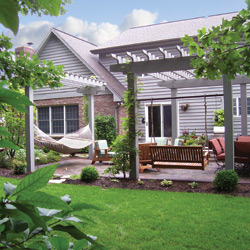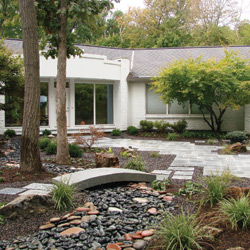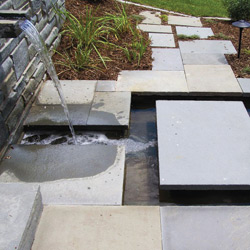You push open a French door to a warm evening breeze that carries with it the perfume of lilacs. You step out onto a spacious slate patio covered by a wooden arbor. The furniture is cozy and welcoming. You sit and look out at the beautiful greenery surrounding you—the twining ivy on the arbor’s columns, the plush grass that welcomes bare feet, the colorful flowers and lush groundcover. You think to yourself that this rich, calming environment is where you’d like to spend every evening. The good news is that you can—it’s your own backyard!
What a difference the proper landscaping can make! As you can see, it’s possible to transform a bare, ordinary backyard into an inviting haven where your family and friends will want to gather. Enhancing your space for entertaining is always a plus and can actually increase the value of your home. Finding ways to customize and beautify the space you’re in can be very rewarding—and this is the perfect time of year to start.
Designing Outdoor Spaces
Landscaping isn’t just about filling your yard with pretty flowers or installing a gazebo or water feature. It’s about making the most out of your land and creating a space you want to live in—not just look at. But improving this part of your home is very different from remodeling a room inside.
While most people think of backyards in terms of open space that can be filled with trees, flowers and architectural elements, landscape architects consider them in a completely different way. According to Johanna James-Heinz, landscape designer for Green View Companies, “Landscape architects approach design by shaping space. They think in terms of enclosure—walls, ceiling and floor—versus openness.”
 Dale Stuber, landscape architect and owner of Stuber Land Design, explains, “An outdoor space truly is a space…It’s not just about decorating the space—you have to create the space. When you’re in a house, the space is created by the walls, the ceiling, the floor. But outside, there may not be a space to start with.” When working with an outdoor space, think in terms of canopy (ceiling), understory (walls), and groundcover (floor).
Dale Stuber, landscape architect and owner of Stuber Land Design, explains, “An outdoor space truly is a space…It’s not just about decorating the space—you have to create the space. When you’re in a house, the space is created by the walls, the ceiling, the floor. But outside, there may not be a space to start with.” When working with an outdoor space, think in terms of canopy (ceiling), understory (walls), and groundcover (floor).
Investing in your property is a great idea, but as with any home project, it takes some planning before you can begin. To make sure you get the results you want, a good first step is to consult a landscape architect or designer.
Creating an Experience
Just as an interior designer would help you sort through the options for remodeling a room inside your house, a landscape architect can provide advice on how to really make an impact outside. For both Green View and Stuber Land Design, the process begins with a consultation and assessment of the property. Consultants speak with homeowners about their likes and dislikes and how they envision the completed project.
“I work to create an experience for them,” Stuber explained. “I’m not really creating brick-and-mortar and trees and flowers—what I’m really creating is an experience. Do they want to enjoy this property, or do they just want it to look pretty? What do they want out of it? If that experience means just a pretty picture to drive up to each night, that’s what I’ll work on—I’ll create that experience for you. If [it] means that ‘we would love to entertain out here, we would love to have some activity for young kids to do in our yard,’ I’ll create that.”
Stuber wants his clients to enjoy their space—have a great Fourth of July party, for instance—because if they’re not having a good time, he believes, they won’t care at all about the plants, flowers or trees that surround them.

James-Heinz puts it this way: “There has to be a delicate balance between [the site, the client and the designer]. “A garden could be worthy of design awards, but if it doesn’t work for the client, it isn’t likely to survive…Great designs require sensitive site analysis and good communication between the client and designer.” When trying to create an outdoor space that is both aesthetically appealing and fits the intended use, she suggests, “Rather than create a grocery list of what items they want, clients should think more in terms of how things should function for them.”
Stuber explains that one of the most important aspects of his job is understanding his clients’ situations. “I have to be a good listener. I have to know things like their relationship with their kids. If this is a man and a woman with six kids in the house, or if they are empty-nesters, that says a lot about what’s going to happen in this backyard. Do these people enjoy cooking outside? Do they entertain friends, or would they if they had the right backyard? Do they have a dog or a cat? Believe it or not, those are hugely important issues.”
According to James-Heinz, “The best relationships occur when clients are open-minded, but not afraid to speak up or ask for an explanation. A good designer should be flexible enough to come up with alternatives if necessary. The idea of ‘one perfect design solution’ exists only in a world without clients. In the end, the clients are the ones who must live with the design.” Stuber adds, “My whole goal is to enhance the home and the property, not to be the main feature.”
After the initial consultation and analysis, the consultant will come up with several designs for clients to choose from. After one is selected, the installation process begins—taking anywhere from half a day to an entire season.
Investing in What You Have
These days, when homeowners are trying to get the most out of their properties, many are investing in their yards instead of in vacations, turning what they already have into homey havens. These staycations positively affect the value of a home, as well as the economy of the local community.
“Another reason I like landscape design,” Stuber says, “is because I’m creating something I think adds value to a piece of real estate, especially when there’s so much [financial] uncertainty. I’m excited about this coming year because, quite frankly…I think people are going to see that value.”
When it comes to the most common ways of adding value, both Stuber and James-Heinz report a recent increase in the demand for outdoor kitchens and living spaces. These two embellishments tend to make the biggest impact, as they add or enhance large, architectural elements like patios, arbors and gazebos. Both experts have also seen an increase in homeowners’ desire to grow their own vegetables. “Whether it’s for the environment, health or taste, growing edibles is in,” says James-Heinz.
 If you’re looking to revamp your house because you intend to put it on the market this year, landscaping is a very good place to spend time and money. Mary Ann Knell, president of the Knell Group, said, “Many years ago, a very wise woman said to me, ‘It’s not my home if I’m not smiling the moment I pull up to it.’ I’ve used that quote so often when preparing my client’s homes for the active market. The bricks and mortar of a home are often capable of being duplicated in many different price ranges, but the framing of a home through tasteful landscaping is a reflection of what will meet the potential buyer as they pass through the entry door. Landscape is the first step in ensuring the homeowner’s investment and value potential.”
If you’re looking to revamp your house because you intend to put it on the market this year, landscaping is a very good place to spend time and money. Mary Ann Knell, president of the Knell Group, said, “Many years ago, a very wise woman said to me, ‘It’s not my home if I’m not smiling the moment I pull up to it.’ I’ve used that quote so often when preparing my client’s homes for the active market. The bricks and mortar of a home are often capable of being duplicated in many different price ranges, but the framing of a home through tasteful landscaping is a reflection of what will meet the potential buyer as they pass through the entry door. Landscape is the first step in ensuring the homeowner’s investment and value potential.”
The Art of Landscape Architecture
Stuber loves helping clients enhance their yards to get the most enjoyment out of their properties, and he thoroughly enjoys the creative side of the business as well. “I love to take a blank slate and create something that, when it’s done, I can enjoy. And I certainly hope that the customer enjoys it.” He considers landscape architecture to be art—but art that follows function. “It has to function first,” he said.
James-Heinz agrees. “[Landscape design] requires problem solving in an artistic way on many different scales. Whether sculpting large spaces or choosing plant combinations, basic design elements come into play.” Composition, line, shape, color, texture, light and balance are all artistic elements applied to landscape design. “Landscape designers,” she added, “also use art to communicate their ideas to clients. Being able to effectively communicate ideas through plan, perspective and sketches requires both artistic and technical skills.”
Whether you’re looking for pure beauty, to improve the value of your home or to create an inviting space to relax and enjoy the company of others, an investment in landscape architecture can make your vision a reality. Professionals will provide a workable plan, and as much of the installation as you like. Enjoy the beautiful summer weather right in your own backyard! a&s


